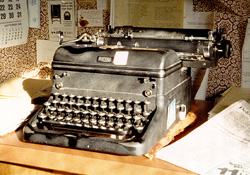Half a century ago, radios throughout the country were broadcasting the news that a woman had died in Missouri’s gas chamber… the first– and so far, the only –woman ever executed in a state prison. Bonnie Brown Heady of St. Joseph and her lover Carl Hall had been convicted less than a month earlier of the kidnapping and murder of a little Kansas City boy, Bobby Greenlease. Former prison caseworker Gail Hughes remembers the Heady execution in an interview with Bob Priddy.
Tag Archives: Bob Priddy
Cursor-cursed funeral parlors.
“Today’s sorry newsrooms–silent, smokeless, boozeless, cursor-cursed funeral parlors–bear no resemblance to the divine hell-holes that persisted at newspapers and wire services until the mid-1970s. They were seas of grunge and debris…a universe of controlled chaos, suspended in a perpetual stinking fog of cigarette smoke and worse.”
— Diana McLellan, journalist, former gossip columnist, and longtime Washington editor of Washingtonian magazine
The first eighteen years
I started working for Clyde Lear in May, 1984. My second job in 30 years. Clyde Lear and Bob Priddy are easily two of the nicest and most talented people I’ve ever met. I’m reminded of the character in Joseph Heller’s Catch-22 who played horseshoes all day. He hated the game and it made the day (and his life) seem longer. I’m having way too much fun and it’s going way too fast. One more movie reference comes to mind. In Broadcast News, William Hurt asks Albert Brooks, “What do you do when your real life exceeds your dreams?” Brooks: “Keep it to yourself.”
The Biology of Typing
I didn’t take biology in high school. My mom called the school and told them she didn’t think I needed to take the course. Turns out she was right. But she insisted I take typing. We used real typewriters. Manuals. There were a few electic typewriters in the back of the room but they seemed too exotic and high-tech to use. Every week or so we had these “timed typing” tests to see how many words-per-minute we could type. There some kind of formula…total words minus number of errors, something like that. I quickly figured out that my best shot was to go wide open, with no regard to errors. I frequently had the best score for a document nobody could read. This was 1964 and computers and word processors were years in the future.
 Twenty years later I started working with a guy named Bob Priddy. Bob was (is) a broadcast journalist, author and –in 1984– power typist. His “office” was a cramped, dusty corner of an attic in Jefferson City, Missouri. The digital newsroom was still a few years off and Bob hammered out his news stories on a battered old Royal typewriter. The floor and walls shook when Bob was on deadline. No IBM Selectric for Bob, he was a manual guy all the way. Bob “keyboards” these days. And if he doesn’t pound the keys as he did back then, it’s only because they couldn’t take the punishment.
Twenty years later I started working with a guy named Bob Priddy. Bob was (is) a broadcast journalist, author and –in 1984– power typist. His “office” was a cramped, dusty corner of an attic in Jefferson City, Missouri. The digital newsroom was still a few years off and Bob hammered out his news stories on a battered old Royal typewriter. The floor and walls shook when Bob was on deadline. No IBM Selectric for Bob, he was a manual guy all the way. Bob “keyboards” these days. And if he doesn’t pound the keys as he did back then, it’s only because they couldn’t take the punishment.
I recently came across an article by Roger Ebert (In Cyberspace, Writing Is A Performance) that reminded me of Bob and his battered Royal.
“A few moments ago I took the L.C. Smith down from the shelf and tried to type on it, and found that I could not. It’s just so klutzy. My fingers have to travel so far and work so hard to depress a key. You have to manually return the carriage at the end of every line. You have to hit the Tab key to indent. My fingers are no longer trained to hold down the Shift key.”
I love email. I’m trying to get comfortable with Instant Messaging but it’s a struggle. Knowing the other person is sitting there (“Mays is typing you a message”), waiting for me to respond. I find myself drifting back to typing class (“Fuck the typos, I’m going for speed!”).
I don’t think they make manual typewriters any more. Seems like I read that some place. I’m tempted to add, “too bad” but I can’t say why. Sort of like me and biology.
